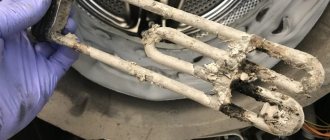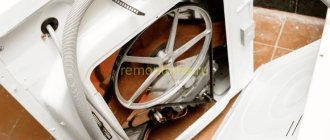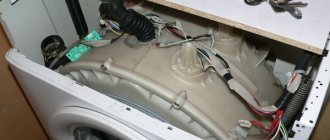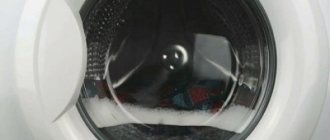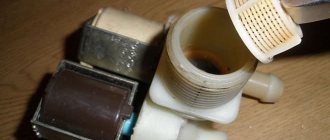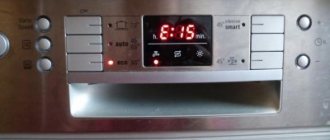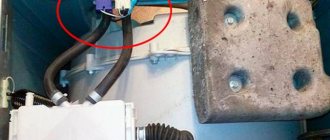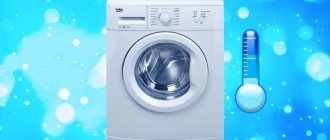Is your washing machine overheating the water? For colored linen, woolen, and cotton items, this can be a disaster: they fade and shrink. Each washing program provides a specific temperature: 30, 40, 60 degrees. Delicate items should be washed in the most gentle mode - no more than 40°C.
Why the machine overheats a lot and how to fix the problem, read our article.
ARDO WASHING MACHINE ON OUR WEBSITE. For free! The instructions can be downloaded or viewed online.
Why can’t heating up the machine be completely avoided?
No matter how elegant and precise your machine is, don’t forget that it has an electric motor inside. And, if you have a good car, this motor is quite powerful. For example, Mustang clippers produce 5,900 rpm. That is approximately 98 revolutions per second! Yes, yes, this is the very time you need to say “one”.
The knives move at incredible speed. Naturally, they heat up - even with good lubrication, the friction force still remains. And the engine itself, which produces such power, gets hot. This cannot be avoided except by turning off the machine.
But. This does not mean that the machine in your hands has the right to turn into a switched-on iron. The design of the machine must be such that the generated heat is distributed and does not cause discomfort during operation. And if the machine starts to heat up indecently, it means that either the design was not reasonable enough from the start, or something happened to the machine.
Possible locations of the problem
Some machines, especially models with automatic self-diagnosis, if they do not heat the water, then immediately refuse to work. While their more responsible brothers continue to perform their main function - washing clothes, albeit in cold water.
If a machine that does not heat the water still continues to wash, this does not mean that the problem does not need to be solved.
The fact is that such incorrect operation can lead to more serious damage. Incorrect operation of the device may be the result of failure of some parts:
- Failures in the sensor
that monitors the water level (then the machine believes that there is not enough water yet and it is too early to heat it). -
leading to the heating element are damaged - Failure of
the heating element
itself (the heating element cannot heat the water due to its own malfunction). - Failure in the sensor
that monitors the temperature regime (the device simply does not understand when and to what temperature it needs to heat the contents). - There is a breakdown in the control module assembly
(the “brain” part of the device does not know what to do).
Each of these malfunctions explains why the washing machine cannot heat the water and the laundry does not wash.
Why does the machine start to get very hot during operation?
The number one reason that accounts for most of the situations when an initially normally working machine begins to overheat is contamination. Hair clippings, deposited sebum, dust - all this increases friction when moving the knives. Accordingly, the system heats up more.
Thus, the first thing to do if the machine starts to heat up is to clean it. This is a subtle matter, but quite real. We wrote about this, it’s better not to repeat it.
So, the machine needs to be cleaned, lubricated, and then examined - and, if nothing has changed, take it to the service center and ask the technician what else could have happened to it.
This, of course, applies to cases when the machine initially worked normally and did not get particularly hot - and then suddenly began to heat up somehow suspiciously. Because many cars start to heat up from the very beginning - fiercely and inconveniently. What to do with such machines?
Thermistor test
Sometimes washing machines heat up the water during rinsing if the thermistors are faulty. They fail less often than heating elements, but they are worth testing from time to time. In addition, removing the temperature sensor from the housing is easier and faster than the heating element, and it is more logical to carry out repair work from simple to complex. The thermostat is located inside the heating element, which in most models is installed in the lower part of the housing. To test the washing machine thermistor, you need to perform the following steps:
- disconnect the device from the power supply;
- remove the rear panel of the machine;
- find the wires that go from the temperature sensor to the external temperature controller. Separate them;
- the screw that holds the tubular electric heater must be loosened;
- remove the sensor from the heating element.
You can handle this work yourself. To check the thermistor you will need a multimeter. Use it to check resistance. They do it like this:
- set up the measuring device to determine resistance;
- attach the probes to the thermistor contacts and check the readings.
If the temperature is +500C, then the resistance value in a working thermistor is approximately 1350 Ohms. If a breakdown occurs, the sensor must be replaced. Installing a new part and assembling the washing machine is carried out in the reverse order. The device is connected to the mains last.
What determines the heating of the machine from the very beginning?
What can you do with a machine that starts to get very hot from the very beginning, even though it is completely clean and lubricated? Well, there are two options - either suffer and endure, or throw it away and buy a normal one.
Because the heating of the machine depends on the rationality of its design and the quality of the selected motor. And if any of this was initially done incorrectly, then the machine can only be remade.
Modern washing machines have dozens of wash programs. Each of them involves heating water to a certain temperature, on average from 30? up to 95?.
Delicate items are washed in cold water, and to remove particularly difficult stains, the water temperature is set to the highest possible temperature.
When washing at maximum temperature (90-95?), the water in the washing machine gets very hot. This happens gradually and only 10-15 minutes after starting the wash.
If you carefully touch the glass of the hatch in the middle of the cycle, you can understand how hot the water is inside.
Heating the temperature of the water in the tank to 100? when it boils
and literally melts the entire unit, indicating a malfunction of one of its important parts.
The washing machine usually begins to overheat and even boil the water in the drum after many years of service due to
wear of parts and frequent power surges.
The exception is a manufacturing defect. In this case, the new equipment gets very hot.
There are several ways to find out that the machine is overheating the water:
- If the water overheating is insignificant
(10-20? higher than it should be) - according to the condition of the laundry after washing. Things fade, shrink, become deformed. - If the overheating is significant
(the water is boiling), the washing machine heats up completely: its body heats up, the air nearby becomes hot, and steam may come out of the top cover.
To understand the reasons for water overheating, you need to understand the principle of its normal operation.
for heating the water in the washing machine :
- The control board
(electronic module or programmer) is the “brain” and mini-computer of the machine, which sends signals about heating/stopping water heating to the heating element (heating element) and receives a signal about the water temperature from the device that measures it (thermostat or thermistor). - Heating element relay.
Disables the heating process of the electric heater. - Thermistor
(if the unit is electronically controlled) or
thermostat
(if the control is electromechanical). These sensors measure the temperature of the water in the washing machine and determine the moment when it has reached the set value; after which the thermistor transmits data to the electronic module, and the thermostat itself turns off the heating element relay.
The heating element heats the water, the temperature sensor measures it, and the control board regulates these processes.
Accordingly, the machine can overheat the water if one of these parts breaks:
- The control board is malfunctioning. You need to reflash it or replace it with a new one.
- Malfunction of the thermistor or its “burnout”. It is necessary to either clean the unit from scale (the thermistor is also susceptible to scale!) or replace the thermistor with a new one. The thermostat can only be replaced with a new one.
- The heating element relay “sticks”. The relay needs to be replaced.
Also, overheating of water in the washing unit can be caused by:
- burnout of internal electrical wiring,
- breakdown of the electric motor.
Repairs of this kind, as well as reinstallation of parts, should only be performed by an experienced and certified technician. Otherwise, the problem of overheating water in the washing machine can result in even greater difficulties and final breakdown of the unit.
Call a VseRemont24 specialist to your home! Diagnostics will show what exactly caused the malfunction, after which a specialist will promptly repair the washing machine.
It is important for the owner of a washing machine that gets very hot to remember safety measures.
If the body of the unit becomes extremely hot during washing, and especially if there are clouds of steam, you need to:
- Stop washing by pressing the “On/Off” button.
- Switch the mode to “Drain”.
- After the machine has drained the water, turn it off and disconnect it from the power supply.
- After giving the machine some time to cool down, remove the laundry from the drum.
If you have the time, effort, knowledge, and tools, you can check the functionality of the water temperature sensor.
Its failure is
the most common
cause of overheating of a washing machine.
To get to the thermostat
, required:
- Disassemble the back of the machine.
- Find the heating element and identify the temperature sensor. They are located at the bottom of the tank at the rear wall.
- Disconnect the wire contacts, loosen the central nut and remove the sensor.
For check
Temperature sensor will require a special device - a tester that measures resistance.
Verification steps:
- Resistance measurement at room temperature.
- Measuring the resistance of a sensor previously lowered and heated in hot water.
The tester readings should significantly
vary. Otherwise, the water temperature sensor is faulty.
Overheating of a car engine is a problem that every driver can face. In this article we can learn: - how to notice in time that the engine has overheated; — why the engine heats up in general and in certain situations; — what to do if the engine overheats.
To understand the essence of the issue, it is necessary to consistently read all the explanations of an experienced auto mechanic.
How to fix the problem
You will need diagnostic equipment, tools: screwdriver, pliers.
Start by checking the thermistor and heater. In washing machines, the temperature sensor is built into the base of the heating element, so you need to reach it.
Depending on the model of the washing machine, the heating element can be located in the front or rear part of the body, under the tank. You can find out exactly in the operating instructions.
If your car has a heating element on the front, you will have to completely disassemble the body, but this is rare. We will consider the option that occurs most often: placing the heater at the rear wall.
- Close the shut-off valve.
- Disconnect the drain and inlet hoses from the housing.
- Unscrew the two top cover screws. Slide it forward and then remove it from the body.
- Unscrew the bolts around the perimeter of the back cover and set it aside.
- Under the tank you will see the leads of the heating element.
If you decide to remove the part, buy a rubber seal. It allows the heater to sit hermetically in the socket, and after dismantling it is damaged and does not perform its functions.
- Disconnect the wiring connectors and inspect the wires for damage. If the insulation is broken or burnt parts are visible, the operation of the element is not controlled by the board. The wiring harness needs to be replaced.
How to determine if the engine is overheated
At first glance it seems very simple - according to the indicators of the engine temperature device, or - sensor. This is true, if not for one thing - novice motorists are so captivated by the road situation around them that they look at the instrument panel only in one case - how much fuel is left. Experienced motorists, on the contrary, due to their confidence in their abilities, also do not look at the car’s dashboard. And as a result, a situation often arises that overheating is detected when the engine temperature has long exceeded permissible limits, and irreparable damage has been caused to the engine. It is irreparable overheating that is one of the most complex malfunctions, which leads to very serious consequences. But more on that later. But there is a way that will not let you miss the moment of overheating. This is problematic in a traffic jam, and is not always clearly present, but here’s what you should be aware of:
As soon as the engine temperature exceeds the permissible norm, when you sharply press the gas pedal, or when accelerating the car, even slightly, detonation knocks can be clearly heard
, which are popularly called “tapping fingers.” This is not true, but everyone knows this definition. If you hear such a sound, there is a 99% chance that the engine has overheated, and action must be taken.
Detonation knock is a loud metallic knock, the frequency of which coincides with the engine speed. You've probably heard such sounds when refueling with low-quality fuel. I personally don’t know where the concept of “tapping fingers” came from. But the real reason for such knocking noises is a disruption in the fuel combustion process. What you hear is nothing more than explosions of the fuel mixture. During normal engine operation, the combustion process is controlled, but as soon as one of the operating parameters is violated, the process goes out of control and combustion turns into an explosion. Hence the concept - detonation (from the word detonate - explode) knocks. When the engine overheats, this is the first sign.
Before continuing the conversation, let's define what is normal temperature and what is overheating. There is no one-word answer, but there are general rules. The engine temperature is within 85-95 degrees Celsius, which is working. Engine temperature up to 100 degrees is acceptable. This means that a short-term increase in temperature to 100, sometimes up to 105 degrees is allowed. Just for a short time - up to 5 minutes. Engine temperature above 105 degrees Celsius means overheating and action must be taken.
Rinse stage. what to consider and how to improve
If you use fabric conditioner to rinse clothes, then pour it into the special compartment of the tray only after you have “filled” the washing machine with water, otherwise you may inadvertently simply wash it away. Of course, this will not increase the energy consumption at home, but the money on air conditioning will be wasted.
Yes, I missed one point. It no longer matters which program to set, that is, the washing temperature, as long as it is not higher than the temperature of the water that you poured in before, otherwise the “smart” machine will begin to heat it up to the set one, and therefore will consume additional electricity. I think it’s easy to determine by the organoleptic method, that is, by touch.
Let's continue about rinsing. Modern washing machines are configured in such a way that not only washing, but also rinsing occurs, practically in a mug of water. For those who are not satisfied with this state of affairs, I suggest the following method. But I warn you right away that it assumes that you will have to be at home at the time of washing. That is, by and large, the automatic function of the rinsing process is lost.
So, we put the machine on the wash, catch the moment when the rinsing process begins, then through the same tray we add cold water to at least a full tank and we can “sleep peacefully.” Unless, of course, you are too lazy or a burden to do this and time allows it. But, in my opinion, many retirees have enough free time, especially when it comes to saving “for the home, for the family” and the quality of the work they do.
Good luck to you! See you soon on the pages of the Penserman blog.
Reasons that can cause overheating
1. Lack of coolant. The liquid in the engine boils not because there is not enough of it, but here’s why: remember about the outer surface for cooling? If there is a lack of fluid, the contact surface between the fluid and the heated engine is insufficient, and heat transfer to the environment is poor. This is where the overheating comes from. The engine cooling system is not sealed, as many believe, and fluid evaporates during operation - do not forget to check its level regularly. And of course, monitor the condition of the radiator and pipes - leaks are unacceptable. There are cases of internal leakage - as a result of damage to the gasket between the head and the cylinder block. Water will not flow out of the exhaust pipe, but a constant decrease in the fluid level without visible leaks is a reason to be wary and contact a specialist. Water accumulated in the cylinders at the moment of starting the engine can lead to water hammer - this can literally destroy the piston group, and not only that.
2. Radiator condition. The gaps between the radiator honeycombs are quite small and can gradually become contaminated by representatives of the insect world. This is not a joke; there was a case when minor contamination of the radiator (coupled with the poor condition of the engine) led to constant overheating of the car. Keep the radiator clean and blow it with compressed air at least occasionally.
3. Incorrectly set ignition angle. If the ignition angle is violated, the fuel combustion process is disrupted. As a consequence, an increase in combustion temperature and a decrease in power. The power has dropped, but there is no need. What are we doing? That's right - press the gas pedal harder. It turns out that more fuel is spent on the design operating mode of the engine (at which normal cooling occurs). Hence the overheating. By the way, an ignition problem can arise (spontaneously, and not after your intervention in the finely tuned engine mechanism) if the timing belt or chain is stretched. This is not the only possibility, but it is common - keep in mind.
4. Fuel quality. An inappropriate octane number leads to a decrease in power and an increase in the temperature of fuel combustion. There is only one way out - refuel in one place, so the likelihood of getting bad gasoline is lower.
5. Deposits on the walls of the engine and radiator. The reason is simple - the use of low-quality coolant, or even water. A little more detail. From a physics point of view, using water is better, since water has better thermal conductivity than alcohol-containing antifreeze. But - there are salts in the water (you can see them on the walls of the kettle) - the same thing happens inside the engine. As a result, water circulation is disrupted, cooling efficiency is reduced and the engine overheats. If you are pouring water into the expansion tank, pour distilled water, it is free of salts. It is best to use special antifreeze. Believe me, it is impossible to completely remove scale from the engine. And one more “beauty of water: if, after water, for example in winter, you fill in antifreeze - be prepared for drips (it can leak anywhere: radiator, pipes) - this is a fact. If you constantly drive “on antifreeze,” nothing will happen, but after water, antifreeze will flow 99%.
6. Engine wear. This can include many aspects, but in most cases it is wear of the piston group. During long-term use of the car, the piston rings, which serve to seal the combustion chamber, wear out, which leads to a decrease in compression, impaired fuel combustion, loss of power (remember the formula) and overheating of the car.
Somehow it turned out to be too difficult. To put it simply: fuel burns better at a certain pressure that is created in the combustion chamber. Pressure is about 12 atmospheres. If you take a pipe, plug it with potatoes and blow inside, pressure will be created inside, which is called compression. The force with which you blow will represent the force of expansion of the fuel during combustion, which pushes on the piston and causes the crankshaft to rotate. The rings serve to fit the piston more tightly to the cylinder (in our case, potatoes and tube). Now, if you put in a loose piece of potato and blow, the air will pass past the potato piston.
This is what happens in the engine when the piston group wears out (ring wear and cylinder wall wear). As a result, part of the expansion energy of the fuel during combustion passes by the piston (between the piston and the cylinder), and compression (optimal pressure in the combustion chamber) decreases, which worsens the quality of combustion. And again - loss of power and overheating. There is only one way out - contact a specialist.
7. Radiator fan. In some (older) car models, there was no such reason, since the fan was driven directly from the crankshaft through a belt. Now, the fans are electric and turn on when the temperature sensor is triggered. The sensor may not work, and the fan may not turn on. This is a fairly common reason. You just have to go out and look - the motor connection contacts may be oxidized.
8. Air pockets formed when filling liquid. By the way, in this case the temperature sensor may not show an increase in temperature. How to get rid of a traffic jam is the topic of a separate article. I’ll add on my own – when pouring liquid into the cooling system, the car must be horizontal.
9. Thermostat. The thermostat divides the cooling system into two circles - small and large. The small one is used to warm up the car (the amount of liquid is reduced, the radiator is turned off), when a certain temperature is reached, the large circle is connected (the radiator is connected). If the thermostat is jammed, then only the small circle is used: the amount of fluid is insufficient, the radiator is turned off - the car is overheating. You can determine this by feeling the lower pipes leading to the radiator: if they are cold and the car is overheated, change the thermostat.
10. Pump. A pump is a pump that forcibly displaces water to improve circulation. By and large, two troubles can happen to the pump: it will simply leak - you will see, and the second, which is more difficult to determine, is wear of the pump impeller. When the impeller wears out, the pump slowly pumps liquid, as a result, the liquid in the engine heats up faster than in the radiator (water circulation worsens). You can tell by uneven heating - the radiator is cold, but the engine is boiling. Attention - the same symptoms occur if the thermostat is malfunctioning or if there is an air lock.
There may also be other reasons - one of which is from the category “you can’t invent it on purpose.” For example, the parking brake is not fully weakened, which leads to the car slowing down, increasing the load on the engine, and overheating. The handbrake cable may get stuck - there was such a case. The car slows down slightly, but this is enough in the heat.
And some people also blame the air conditioner on. By and large, this is rather a far-fetched reason. Of course, the air conditioner creates additional load on the engine, but this was taken into account during the development. If the engine is really bad - complete wear and tear - then this can happen. What to do - turn off the miracle of modern automobile manufacturing.
Perhaps we'll stop there. The only thing we'll talk about at the end is overheating in a traffic jam. No one is immune from this.
Causes of water accumulation
For what exact reason can water accumulate in the drum of a washing machine? After all, current washing devices are protected against leaks.
Everything is done so that water cannot leak out and cause a flood. There are also washers with check valves if you don't have access to your machine.
And yet, even with safety (and prevention) measures taken, water may continue to appear.
It is important to identify the primary source of water entering the washing machine drum during rest. Let's analyze and find out what color the water in the machine is?
Let's analyze and find out what color the water in the machine is?
- With dirty water and sewer stench, we have a sewer problem.
- If the water is not dirty and does not stink, there are problems with the plumbing and some minor problems in the device itself.
If the machine is not connected according to the rules, then, of course, problems will arise with the sewerage system, and the water drainage will stop functioning.
This, as a matter of course, begins to cause the appearance of water in the tank, plus several more malfunctions discovered by chance add to the trouble. Let's look at a few specific examples of how water appears in the drum of a washing machine.
Water from a non-working washing machine
Let's say: the machine is not in use, but there is still water in the device and does not pass through. First you need to turn off the water tap.
If, thanks to this action, the problem was not solved, then the issue will be in the unreal functioning of the water drain. Quite often it happens that water from the drain gets into the machine.
The reason for such a mistake is the inaccurate location of the connection to the sewer system. This means that you should look at the device connection again.
If everything is done properly, then the source of the problem is most likely a blockage inside the device itself.
Everything that flows from the sewer will collect inside the machine, and not finding a way out, will rise through the hose. But what to do? We need to get rid of this kind of blockage.
If the water in the washing machine tank does not go away, then you may have to completely disassemble your washing machine. There is also the option of a faulty locking input. But why might this happen?
- If the water used for washing is of poor quality, then it may contain gravel and some other small stones. The result will be valve clogging and complete failure.
- There is a possibility of valve wear. Everything is much simpler here, because this can be solved by a simple replacement.
In addition, in such a situation there is a possibility of a wiring fault, which also affects the valve. To diagnose, contact the specialists from the service centers for purchasing your equipment - they will be able to identify the broken part and carefully repair everything.
If you cannot fully rely on yourself, then you should still turn off the water tap and call a specialist.
Drain filter clogged
This is a staged situation: you washed, and after the spin cycle there was still water left. In order to eliminate this problem, you need to monitor the drain system and filter from time to time.
The most common reason for water appearing in a washing machine is a clogged drain filter. We do everything according to the following plan:
- We manually drain all the water from the hose - otherwise there is a risk of liquid spilling onto the floor.
- We unscrew the filter and actively rinse it with tap water.
- Let's look at the pump located behind the filter: turn on the drain mode and see if the pump blades rotate.
- If dirt is clogged in the pump, then clean this area as well.
- Put everything back and turn on the drain program again. If everything started to work correctly, then the reason lay in a contaminated drain.
Broken pump
If you disassembled the filter and pumps to check for dirt, but this did not give visible results, then the breakdown may be much more serious than we expected.
If the washer still tries to drain the liquid and makes too much noise, then most likely it is time for a major overhaul of the pump. How to check for her incapacity?
If the pump impeller does not move when draining, then it is the reason for poor performance.
In this case, independent repair is almost impossible, so it is better to call a specialist. In 90% of cases, the problem of a broken part is solved by purchasing a new one and replacing it at home.
You can buy a new pump yourself or by asking the service center employees to choose the one you need. They will be able to give advice on where to purchase the pump model that is right for you.
What to do if your car overheats in a traffic jam
When driving a car for a long time in a lower gear, the engine operates with increased power, which in itself leads to overheating. Add to this the lack of counter-flow of air necessary to cool the radiator. What to do? The main thing is not to panic. Short-term overheating is not terrible, but if you see that the car is not cooling down, it’s time to act.
Important - do not turn off the engine unless absolutely necessary. Exactly - without extreme. A stalled, overheated engine is an almost 100% guarantee of repair. It will take quite a long time to describe what is happening in the engine in this case (rotating the liners together with the crankshaft, when the engine is subsequently started - the least of the possible troubles), just take it on faith.
Important - do not think about pouring water on the engine or pouring cold water into the radiator. The result is the same - repair. Moreover, you can try so hard that you cannot do without replacing the block and cylinder head. Another “beauty” of cold water is microcracks inside the block. Finding and eliminating will be very, very difficult, if not impossible. The car has overheated - try to pull over to the side of the road. If it doesn’t work out, don’t panic and don’t pay attention to those around you – it’s important for you to save the engine.
Stop at idle, turn the heater on full, and wait. If after 5-10 minutes the situation does not improve, turn off the engine. It’s a good idea to open the hood; the main thing in a panic is not to forget to set the car’s parking brake.
The only reason to turn off the engine right away is clouds of steam coming from under the hood.
Most likely, the cooling pipe has burst, and further operation of the engine will only worsen the situation.
This is what it looks like, engine overheating, if you look closely. Now you know why the engine gets hot and how to deal with it.
Regardless of the model manufacturer, be it LG or Indesit, the washing machine may break down one day. There are different breakdowns, for example, the machine knocks out the plugs, does not heat the water, the device itself gets hot. In any such situation, the owner of the machine must prevent breakdown. Let's take a closer look at the reasons why the washing machine gets very hot.
Debugg
After identifying a malfunction resulting in the washing machine not heating the water, you need to fix it. You can do this as follows:
- Clean or replace the water level sensor tube.
- Replace or solder and insulate damaged wires.
- Remove scale from the heating element by boiling it in water with citric acid.
- Replace the heating element with a new one.
- Replace the temperature sensor.
- Replace or repair the control module.
It is better to entrust the replacement of the control module to professionals, and in some cases simply purchase a new device, since the replacement procedure can be more expensive.
If the water in the washing machine does not heat up, you need to find the cause of the equipment malfunction and try to eliminate it. If difficulties arise, it is better to contact a repairman. And if the washing machine is under warranty, then contacting the service center is mandatory without attempting to fix the problem yourself.
Temperature
Sometimes it all comes down to the temperature of the water at which the clothes are washed. After all, one mode provides 30-40°, and the other – up to 95°. In the latter case, the Bosch Max 4, Indesit or LG machine actually heats up noticeably along with the water.
If the water does not heat up, then the body of the technical device will not change its temperature at all. Then we can safely say that there are problems with heating the liquid.
Why does the water in the washing machine not heat up?
- Incorrect connection (unauthorized discharge of liquid into the sewer).
- Wrong choice of program due to inattention.
- The heating element (heater) burned out. This could happen due to age, manufacturing defects, short circuit.
- The temperature control sensor is broken.
- The programmer is faulty (microcracks on the track, broken firmware).
If the problem is not the temperature, but the machine gets very hot immediately after purchase, it makes sense to take it under warranty and have it checked or call a repairman to your home. Sometimes the problem is a low-quality product.
The plug gets hot
When it seems that the washing machine is heating up, you need to disconnect it from the power supply. This is very easy to do if you unplug the plug from the socket. What if the owner of the device noticed that not only the top case, but also the wire got hot?
Why does the plug of the washing machine get hot along with the wire?
- Prohibited load. Companies that produce low-quality products provide a minimum safety margin due to load. In such a situation, you will have to change the plug and wire.
- Faulty socket. You should pay attention to the temperature of not only the plug, but also the socket; in this case, the plastic may become charred, and its fastening will noticeably weaken.
- Wiring. Also, the Soviet aluminum cable cannot withstand modern loads, since now a washing machine, TV, hair dryer, iron, computer and other appliances are working simultaneously in the apartment. The wiring simply cannot cope with such a load, so for safety reasons (possible short circuit and fire) it is best to replace it.
What heats the water?
A tubular electric heater is the very element that is responsible for heating water
in the tank.
According to the principle of operation, it is similar to a regular boiler. The heating element lasts a long time, but it is affected by the quality of the water
: if there are a lot of salts in it, scale accumulates on the spiral, which, due to its thermal insulation properties, greatly interferes with heating.
Interesting materials:
How to delete a message on What's up? How to delete a message in mail ru dating? How to delete a message in Zoom on your phone? How to delete a VKontakte message from yourself and your interlocutor? How to delete messages from Trash in Gmail? How to delete messages from Apple watch? How to delete messages from MacBook? How to delete messages from Badoo? How to delete messages on Facebook messenger? How to delete messages in GTA 5?
Electric motor failure
The engine stops working for a variety of reasons. For example, due to the drum of an LG or Indesit washing machine being overloaded with clothes, a change in its power, worn out or “non-original” brushes. The panel heats up - this is why the motor becomes faulty.
If the washing machine engine is heating up, you can smell the wife's characteristic smell of rubber or plastic. Even if the wires do not burn, overheating can be easily checked by lightly touching the motor.
The engine is not repaired; usually it is immediately replaced with a new one. Don't wait until the washing machine starts smoking. In the event that the owner of a piece of equipment discovers that it is heating up, you should call a technician or, if you have the skills, carefully inspect the engine yourself.
Why else do LG or Bosch Max 4 devices overheat:
- short circuit in the control board;
- object hitting heater or motor;
- the contact of the tubular electric heater is burnt;
- short circuit;
- The thermostat has failed.
What to do?
The first step is to carefully inspect the washing machine and turn off the power by disconnecting the plug from the outlet. Now you need to determine the cause of the breakdown, without which the equipment cannot be repaired.
It’s better not to do this yourself, but to trust professionals in their field, especially when:
- the case gets very hot;
- heating temperature is very high;
- The glass of the washing machine is heating up.
After diagnosing, repairing or replacing a faulty part, the technical product will work as before.
Selecting parts yourself sometimes just means wasting money. A beginner cannot always figure out which material is best to choose a part from, which in the end simply won’t fit the machine.
If the washing machine is heating up, there is no need to wait until it smokes. There are many reasons why you may notice that the panel on top or the glass is heated. Any minor breakdown can completely disable the device.
Voltage fluctuations, long service life or low-quality parts can lead to overheating of the device and its rapid failure. Equipment for washing clothes is not an exception. If your washing machine is overheating, it is not always easy to determine the cause. Let's look at possible malfunctions and also talk about how to fix them.
The power cord or plug is getting hot
Symptoms: The power cord, plug, or outlet is noticeably warm.
The reason may be the incompatibility of the types of plug and socket: when you plug a new plug into a “Soviet” socket, the contact will be incomplete, which will cause both to heat up. Also, you should not plug many appliances into one outlet; it is better if the outlet for the washing machine is individual.
Basic maintenance does not require much effort. And it is much cheaper than calling a specialist and purchasing spare parts on https://master-plus.com.ua/. Here we have collected the main reasons why a washing machine motor fails.
Causes of engine overheating
Most often, malfunctions of the main element of the washing machine are caused by the following factors:
Dirt accumulation. It can get inside the motor, shorting the contacts and clogging the winding. The engine may not start at all, but only hum (and consume a lot of electricity). If the circuit breaker does not trip, the energized motor will overheat. When this continues for a long time, individual elements may catch fire.
Worn bearings. Worn bearings can lead to increased load on the engine (especially if the drum is full to the top). Failure of any bearing can cause premature engine burnout. Dirt only speeds up this process. It gets into moving parts and contributes to their abrasion. Unfortunately, washing machine motors are not designed for dismantling and repair. They need to be changed completely.
Worn drive belt. Like car belts, in the washing machine they also fray over time, weaken and need to be replaced. Adjusting the tension of the new belt is important. A belt that is too tight increases the load on the bearings, damaging them and causing the motor to burn out. Check your washing machine manual to find out the optimal belt tension.
Overload. Each washing machine is designed to process clothes of a certain weight. If it is exceeded, the engine begins to overheat. Bearings wear out faster, which further increases the load on the motor. Do not exceed the manufacturer's recommended clothing weight. Load items so that they are evenly distributed in the drum.
Everyday life sometimes brings us unpleasant surprises. They are associated with equipment failure. As usual, the first trouble is the heating of the electrical wire, which entails many problems.
Why does the washing machine get hot?
If this happens to you, there may be several reasons for the malfunction. This is not always due to improper operation of the device - over time, its main components begin to fail, as a result of which the washing machine overheats.
Let's say your machine heats the water temperature to boiling - this is unacceptable, as it can ruin things and... Why does this happen? You set the temperature when you set the machine’s operating program. Usually there is a special regulator on its panel for this purpose. During washing (not immediately, but after a while), the heating element automatically turns on and begins to heat the water. In order to turn off this element, the device must “determine” that the desired temperature has been reached. For this purpose, the machine has a special thermostat. If it breaks down, the device can boil water, since the command to stop the heating element does not work. If the washing machine or its body overheats greatly, the problem may be burnt wiring or failure of the electric motor.
Signs and causes of the problem
If the washing machine constantly heats or boils water, parts have worn out. How to notice it:
- With slight overheating (by 10-20°C), things can fade and shrink even at 30 degrees.
- When boiling, you may notice steam coming out from behind the door. The walls of the machine will be hot.
What to do. Before looking for the cause of the problem, interrupt the washing program and unplug the appliance. Try running the drain mode: if the water is very hot, it is better to wait a few hours until it cools down. Boiling water can damage the hoses and pipes of the SMA.
If the drain does not start, wait until it cools down and do it through the drain filter.
When the tank is unloaded, you can begin diagnostics. To do this, it is important to understand the heating principle in the washing machine of Bosch, Siemens, Electrolux and other brands.
How is water heated in the SMA?
As soon as the tank is full, the machine starts heating:
- The control board sends a signal to the heating element to start working.
- As soon as the temperature reaches a predetermined level, the thermistor reports this to the module.
- The control element gives the heating element a command to stop working.
If one of the three parts breaks or their operation malfunctions, the washing machine begins to boil water. An additional reason could be burnt out wiring.
What to do if your AEG washing machine overheats
If it gets very hot, check the functionality of the temperature sensor. Most often it is located at the very bottom at the base of the tank tank in the rear part. Disconnect from the wires and remove it from the machine. Use a tester to check its resistance. To do this, first immerse the element in hot water. If the resistance does not change or changes only slightly, then the thermostat is faulty.
If the wiring shorts and the machine heats up because of this, inspect it for places where insulation has boiled and burnt areas. Replace damaged wires. If the breakdown is difficult to detect or the electric motor of the washing machine gets hot, you will most likely have to contact a special service. Also, without special skills, you will not be able to repair a damaged microcircuit on your own.
Foreign objects in the heating element
Symptoms: the body becomes noticeably hot in places or there is a burning smell.
If metal objects get inside the machine, they may come into contact with the heating element, as a result of which heat will be transferred to the body of the washing machine. If heating of the case is noticeable in the area of the back cover, it must be removed and the space around the heating element inspected: remove any foreign objects near it.
If, for example, plastic parts are pressed against the heating element, when washed they will begin to heat up and emit an unpleasant smell of burning plastic. Again, remove the back cover and remove the uninvited guests.
Emergency procedures
For many years now, automatic washing machines (hereinafter also referred to as SM, SMA) have freed people from the routine work of washing clothes. They themselves heat the water to the required temperature, dose out the washing powder, determine the washing, rinsing and spinning time, and even dry the washed clothes. Leading manufacturers of washing equipment - Bosch, Samsung, Beko, LG, Electrolux and others - equip their washing equipment with a leakage protection system that blocks the flow of water and flooding of premises. But, unfortunately, leaks are still quite common.
If you see a leak on the floor, under no circumstances step into the puddle or try to wipe it away! It is necessary to immediately turn off the power to the unit by unplugging the plug from the socket. If the SM remains energized, it will pose a threat to the lives of others.
The second urgent step is to turn off the water supply to the machine by turning the appropriate tap. After this, you will have to drain all the liquid from the unit using the emergency drain hose. What it is? The emergency pipe is a small hose with a plug, located behind a special door next to the drain filter.
If there is no emergency hose in the SMA, water is drained through the filter hole in the front panel
Next, empty the drum of laundry. Only after all the above steps can you begin to inspect and find out why the washing machine is leaking.
Thermistor test
Sometimes washing machines heat up the water during rinsing if the thermistors are faulty. They fail less often than heating elements, but they are worth testing from time to time. In addition, removing the temperature sensor from the housing is easier and faster than the heating element, and it is more logical to carry out repair work from simple to complex. The thermostat is located inside the heating element, which in most models is installed in the lower part of the housing. To test the washing machine thermistor, you need to perform the following steps:
- disconnect the device from the power supply;
- remove the rear panel of the machine;
- find the wires that go from the temperature sensor to the external temperature controller. Separate them;
- the screw that holds the tubular electric heater must be loosened;
- remove the sensor from the heating element.
You can handle this work yourself. To check the thermistor you will need a multimeter. Use it to check resistance. They do it like this:
- set up the measuring device to determine resistance;
- attach the probes to the thermistor contacts and check the readings.
If the temperature is +500C, then the resistance value in a working thermistor is approximately 1350 Ohms. If a breakdown occurs, the sensor must be replaced. Installing a new part and assembling the washing machine is carried out in the reverse order. The device is connected to the mains last.
Reasons for a non-working centrifuge
There are several reasons that cause the problem:
- Damage to the safety sensor.
- Brake pads.
- There is a problem with the timer.
- Damage to the electrical winding.
- Other causes of malfunctions.
Damage to the safety sensor
Some models, such as Daewoo or Saturn, have a sensor on the door that closes the centrifuge tank. It is needed to disable startup. To get to it, you will need to remove the top panel of the washing machine - under it there is a sensor with 2 contacts that need to be treated with a cotton swab dipped in alcohol. There is no need to scratch the contacts with a knife or clean them with sandpaper. Then you need to check the operation of the sensor. The contacts must close when the cover is closed.
Brake pads
What is the principle of braking in semi-automatic cars?
The brake pads are installed under the centrifuge, and thus slow it down when opening.
The pads are connected to the cover using a cable. When the lid is opened, the cable is tensioned and
The pads fit around the part of the engine that rotates. Thus, the centrifuge stops.
It is necessary to open the rear wall of the brake pad and check how the cable is tensioned so that the pads do not touch the engine when the door is closed, since touching the brake pads may prevent the electric motor from starting.
Timer fault
In most semi-automatic washing machines (SMP), the timer is located under the top panel of the device. It can be repaired by cleaning the contacts.
There are many tips on how to remove the panel, since washing machines from different companies are designed differently.
Once you remove the top panel, you will notice a device that resembles a clock with gears.
There are contacts inside this device that can burn out over a long period of use. The reason is soot, which does not allow current to pass through.
It is necessary to disassemble the timer very carefully, since the cover of this mechanism also serves to attach gears to it. Having unscrewed all the screws, you need to remove it in such a way that the gear wheels do not fall out when opening
If you're worried that you won't be able to open the lid carefully, then it's better to play it safe and take a photo of the entire mechanism. After removing the cover you will notice the contacts. They need to be wiped with alcohol, just like in the sensor.
Damage to the electrical winding
Very often, the burnout of one of the windings of the electric motor is the cause of its breakdown.
This can be checked using a tester, that is, a measuring device. Here are three steps on how to do it.
- First, we find the ends of the wires that come out of the electric motor. Usually there are three wires: the first is common, the second is the one that leads to the starting winding, and the third leads to the working winding. Usually the common wire is marked with the letter “N” and is blue.
- You need to set the resistance test on the device, and measure it between the common wire and one of the other two, for example, red. If the resistance readings of the device are present on the screen, then everything is in order with this winding.
- We do the same with another pair, with a common and, say, white wire. Then we measure the resistance and note the readings of the device. If there is no resistance, then this means that the winding has burned out. That is, the reason that the centrifuge in your semi-automatic machine does not work is a malfunction of the electric motor.
In this case, there are two options: buy and install a new motor or recycle the old one.
